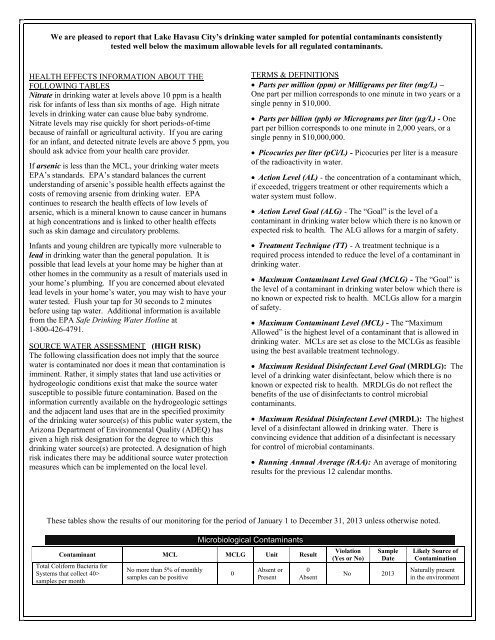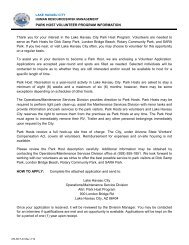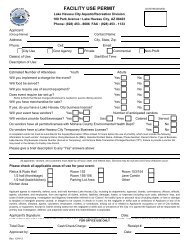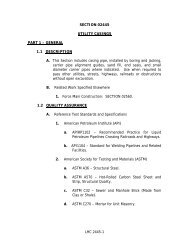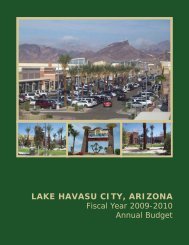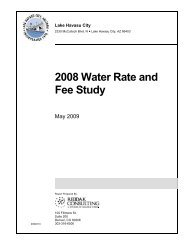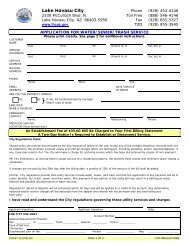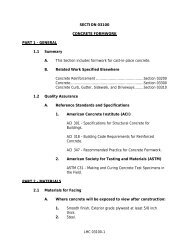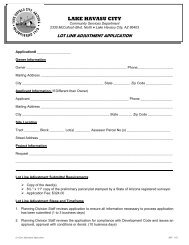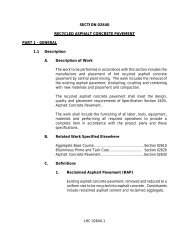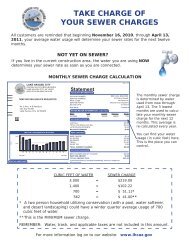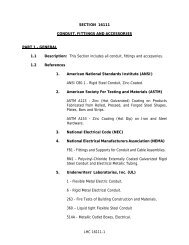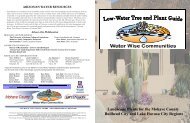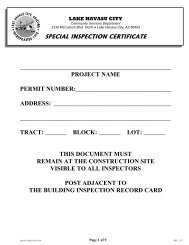Water Quality Report - Lake Havasu City
Water Quality Report - Lake Havasu City
Water Quality Report - Lake Havasu City
You also want an ePaper? Increase the reach of your titles
YUMPU automatically turns print PDFs into web optimized ePapers that Google loves.
We are pleased to report that <strong>Lake</strong> <strong>Havasu</strong> <strong>City</strong>’s drinking water sampled for potential contaminants consistently<br />
tested well below the maximum allowable levels for all regulated contaminants.<br />
HEALTH EFFECTS INFORMATION ABOUT THE<br />
FOLLOWING TABLES<br />
Nitrate in drinking water at levels above 10 ppm is a health<br />
risk for infants of less than six months of age. High nitrate<br />
levels in drinking water can cause blue baby syndrome.<br />
Nitrate levels may rise quickly for short periods-of-time<br />
because of rainfall or agricultural activity. If you are caring<br />
for an infant, and detected nitrate levels are above 5 ppm, you<br />
should ask advice from your health care provider.<br />
If arsenic is less than the MCL, your drinking water meets<br />
EPA’s standards. EPA’s standard balances the current<br />
understanding of arsenic’s possible health effects against the<br />
costs of removing arsenic from drinking water. EPA<br />
continues to research the health effects of low levels of<br />
arsenic, which is a mineral known to cause cancer in humans<br />
at high concentrations and is linked to other health effects<br />
such as skin damage and circulatory problems.<br />
Infants and young children are typically more vulnerable to<br />
lead in drinking water than the general population. It is<br />
possible that lead levels at your home may be higher than at<br />
other homes in the community as a result of materials used in<br />
your home’s plumbing. If you are concerned about elevated<br />
lead levels in your home’s water, you may wish to have your<br />
water tested. Flush your tap for 30 seconds to 2 minutes<br />
before using tap water. Additional information is available<br />
from the EPA Safe Drinking <strong>Water</strong> Hotline at<br />
1-800-426-4791.<br />
SOURCE WATER ASSESSMENT (HIGH RISK)<br />
The following classification does not imply that the source<br />
water is contaminated nor does it mean that contamination is<br />
imminent. Rather, it simply states that land use activities or<br />
hydrogeologic conditions exist that make the source water<br />
susceptible to possible future contamination. Based on the<br />
information currently available on the hydrogeologic settings<br />
and the adjacent land uses that are in the specified proximity<br />
of the drinking water source(s) of this public water system, the<br />
Arizona Department of Environmental <strong>Quality</strong> (ADEQ) has<br />
given a high risk designation for the degree to which this<br />
drinking water source(s) are protected. A designation of high<br />
risk indicates there may be additional source water protection<br />
measures which can be implemented on the local level.<br />
TERMS & DEFINITIONS<br />
Parts per million (ppm) or Milligrams per liter (mg/L) –<br />
One part per million corresponds to one minute in two years or a<br />
single penny in $10,000.<br />
Parts per billion (ppb) or Micrograms per liter (µg/L) - One<br />
part per billion corresponds to one minute in 2,000 years, or a<br />
single penny in $10,000,000.<br />
Picocuries per liter (pCi/L) - Picocuries per liter is a measure<br />
of the radioactivity in water.<br />
Action Level (AL) - the concentration of a contaminant which,<br />
if exceeded, triggers treatment or other requirements which a<br />
water system must follow.<br />
Action Level Goal (ALG) - The “Goal” is the level of a<br />
contaminant in drinking water below which there is no known or<br />
expected risk to health. The ALG allows for a margin of safety.<br />
Treatment Technique (TT) - A treatment technique is a<br />
required process intended to reduce the level of a contaminant in<br />
drinking water.<br />
Maximum Contaminant Level Goal (MCLG) - The “Goal” is<br />
the level of a contaminant in drinking water below which there is<br />
no known or expected risk to health. MCLGs allow for a margin<br />
of safety.<br />
Maximum Contaminant Level (MCL) - The “Maximum<br />
Allowed” is the highest level of a contaminant that is allowed in<br />
drinking water. MCLs are set as close to the MCLGs as feasible<br />
using the best available treatment technology.<br />
Maximum Residual Disinfectant Level Goal (MRDLG): The<br />
level of a drinking water disinfectant, below which there is no<br />
known or expected risk to health. MRDLGs do not reflect the<br />
benefits of the use of disinfectants to control microbial<br />
contaminants.<br />
Maximum Residual Disinfectant Level (MRDL): The highest<br />
level of a disinfectant allowed in drinking water. There is<br />
convincing evidence that addition of a disinfectant is necessary<br />
for control of microbial contaminants.<br />
Running Annual Average (RAA): An average of monitoring<br />
results for the previous 12 calendar months.<br />
These tables show the results of our monitoring for the period of January 1 to December 31, 2013 unless otherwise noted.<br />
Microbiological Contaminants<br />
Contaminant MCL MCLG Unit Result<br />
Total Coliform Bacteria for<br />
Systems that collect 40><br />
samples per month<br />
No more than 5% of monthly<br />
samples can be positive<br />
0<br />
Absent or<br />
Present<br />
0<br />
Absent<br />
Violation<br />
(Yes or No)<br />
Sample<br />
Date<br />
No 2013<br />
Likely Source of<br />
Contamination<br />
Naturally present<br />
in the environment


